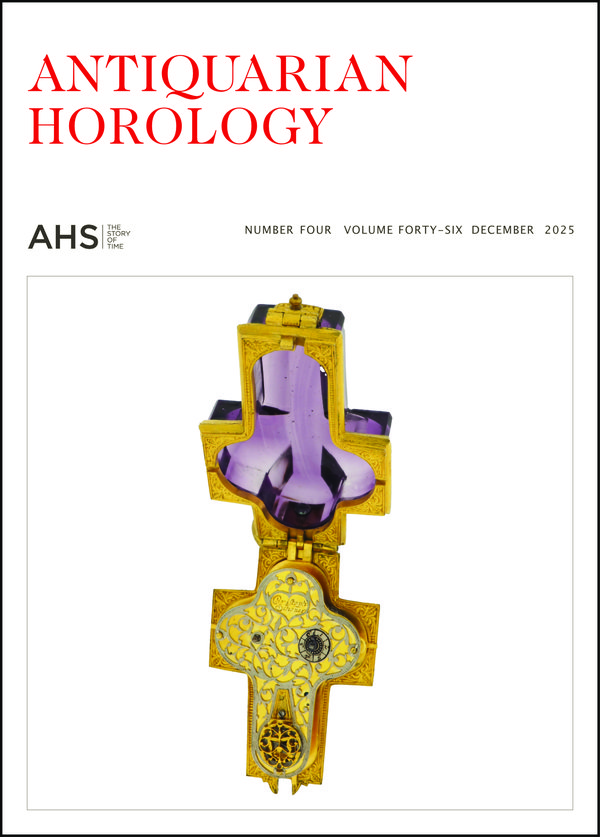Current issue of Antiquarian Horology

Volume 46, Issue 4, December 2025
On the front cover: The ‘amethyst cross’, the subject of a fascinating article in this issue about the return to the Vienna Clock Museum of a cruciform watch lost during WW2. Photo Simon Bull
This issue contains the following articles:
George Lindsay – Watchmaker to George III, 1760–1776. Part 1
by David Green, (pp. 466-484)
Summary: George Lindsay was an eighteenth-century, London-based watch-, clock-, and instrument maker. The records associated with Lindsay are dominated by two events that mark him out from most of his contemporaries: he patented a portable microscope in February 1742/3 that sold well, and he became Watchmaker to George III from late 1760 until his death in 1776. Part 1 discusses his biography; in Part 2 we will examine extant examples of his output, which falls into three categories: watches, clocks, and microscopes.
‘I was lost, but now I am found’: the long journey of a seventeenth-century cruciform watch’
by Tabea Rude and Simon Bull, (pp. 485-508)
Summary: A crucifix watch made by Christoph Schöner in Augsburg in the late seventeenth century, possibly a gift to his wife, became the most treasured possession of the celebrated Viennese collector Baroness Marie von Ebner-Eschenbach, two centuries later. On her death in 1916, her collection formed an important nucleus within the newly created Vienna Clock Museum, brainchild of Rudolf Kaftan, himself another obsessive collector. Along with everything else in the collection, the watch was consigned for safe storage towards the end of the Second World War. However, far from being safe, more than 80 per cent of the Ebner-Eschenbach watches were lost to looting and theft, including the cruciform watch. In early 2025, painstaking long-term research made possible in large part by modern digitising and networking finally confirmed that the watch had been identified once more and ultimately led to the donation and return of the watch to join its fellow survivors at the Vienna Clock Museum, where it is once again on display. (Read this article here)
Belgian carillons in UK clock towers. Part 2
by Darlah Thomas, (pp. 509-522)
Summary: This article centres on the carillons of bells which were imported from Belgium and the newly developed carillon machine manufactured by Gillett and Bland from 1867–8 in projects in the UK: three for churches and one for a private setting. In Part 1, we discussed the carillons supplied to St Botolph’s Church, Boston, Lincolnshire, and Saint Peter and Saint Paul’s church, Cattistock, Dorset. The second and final part looks at those supplied to Eaton Hall, Cheshire, and St Nicholas’ Kirk, Aberdeen.
Restoration of George Margetts No. 1219
by Patrick Woodward, (pp. 523-528)
Summary: This article aims to document the existence and restoration of a pocket chronometer by George Margetts with clear colour photographs of internal components, along with an explanation of a spring detent escapement which does not seem to have yet been documented. Since this watch dates to such a late point in Margetts’ life it is likely to have been finished by his apprentice James Hatton.
Dating an Empire pendule
by Erik Glasius, (pp. 529-535)
Stylistic characteristics of the case and its ornaments and the (replaced?) pendulum make it possible to approximate the date of an Empire pendule within some eleven years. A clockmaker, a cabinet-maker, a caster and Emperor Napoleon provide clues in this assessment. First of all this article discusses the emergence of a new type of clock case, followed by some remarks on the ornaments: the sphinxes. Finally attention is given to the eagle on the pendulum.
Museum profile: The Neulussheim Turret Clock Museum
by James Nye, (pp. 536-540)
Picture Gallery: Objects as Horological Ephemera
by Anthony Turner (pp. 541-547)
‘Unfreezing Time #24’ by Patricia Fara (pp. 552-553) (Read the whole series of articles here)
The issue totals 148 pages and is illustrated mainly in colour, and is completed by the regular sections Horological News, Unfreezing Time, Notes from the Librarian, Book reviews, AHS News, Letters and Further Reading.